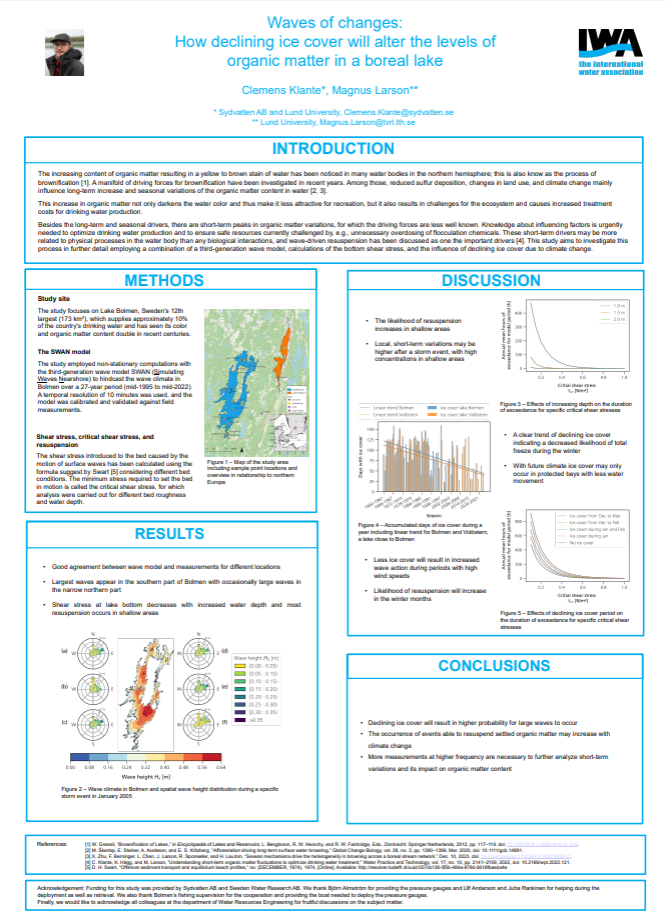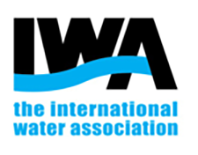
Sydvatten på IWAs världsvattenkongress i Toronto
Temat för årets världsvattenkongress är “Shaping our Water Future”.
Programmet innehåller mängder av möjligheter till inspiration, utbildning, kunskapsutbyte, innovation och nätverkande inom en omfattande rad viktiga ämnen som alla relaterar till vår viktigaste naturresurs – vatten.
Världsvattenkonferensen 2024 sammanför en global publik på tusentals personer från vattenbranschen; allmännyttiga och industriutövare, regeringstjänstemän, NGO-representanter, teknik- och tjänsteleverantörer, konsulter, media och andra.
Sydvatten är medlemmar i IWA och delar av personalen deltar genom att hålla presentationer, workshops, vara med i debattpaneler samt moderera sessioner.
Måndag
Jenny Åström och Kenneth M Persson håller i workshopen Reuse And Recycle Waterworks Sludge.* Kl 15:30-17:00. Rum 714.
Tisdag
Jenny Åström deltar i workshopen Mission-Driven Innovation for Systemic Transformation of Water Management som arrangeras av innovationsprogrammet Water Wise Societies. Kl 10:30-12:00. Rum 718B.
Jenny Åström presenterar Carbon Footprint In Water Infrastructure Projects ** under programpunkten Session Sustainable Approaches To Asset Management. Kl. 13:30-15:00. Rum 701B.
Onsdag
Jenny Åström modererar den tekniska session: Water Resources Management Towards Sustainable Development Goals (SDG): Water Saving, Reuse and Alternative Sources. Kl 10:30-12:00. Rum 701A.
Poster presentation
Poster av Clemens Klante och Magnus Larsson: Waves of Changes: How declining Ice Cover will alter the levels of organic matter in a boreal lake. ***
* Reuse And Recycle Waterworks Sludge
The water sector uses substantial amounts of treatment chemicals. Most commonly these are used linearly. Both the environment and the economy benefit from a more efficient use. Process optimization of chemical dosing, reuse of sludge material and recycling of sludge chemicals are methods to decrease the use of virgin chemicals.
In this workshop we are focusing on good examples of how treatment chemicals and sludges are reused and recycled, to initiate a discussion on proper strategies for chemicals and sludge management in the water industry. We also present technologies aimed at maximizing the potential for recovering and reusing valuable materials highlighting the tremendous opportunities for resource recovery and sustainability in both water and wastewater treatment processes.
How do we better use value in the chemicals? It is possible to re-loop all chemicals of the water sector, so the processes become totally circular also in terms of chemical use?
Participants:
Jenny Åström, chairperson, head of sustainability, Sydvatten, Sweden
Lars Bergmann, presenter, panel participant, EasyMining Germany, Germany
Julian Muñoz Sierra, presenter, panel participant, KWR Water, the Netherlands
Kenneth M Persson, panel participant, Sydvatten, Sweden
Doeke Schippers, presenter, panel participant, Vitens, the Netherlands
| Time | Presenter | Title |
| 15.30 | Jenny Åström | Introduction to the workshop and examples from Sydvatten- ReFerric and more. |
| 15.45 | Lars Bergmann | Innovative Technologies for Chemical and Nutrient Recovery and Recycling |
| 16.00 | Julian Muñoz Sierra | Collaboration and utilization of residual material for reuse through AquaMinerals, NL. |
| 16.15 | Doeke Schippers | Vitens’ experiences of reuse of waste streams from waterworks. |
| 16.30 | Panel discussion, interactive with the audience | Why is not more done and how can stakeholders be facilitated to act? Next steps for the sector? |
| 16.55 | Jenny Åström and Kenneth M Persson | Summary and next steps |
** Carbon Footprint In Water Infrastructure Projects
Abstract: The Swedish water utility Sydvatten has implemented climate calculations in early stages of all new infrastructure projects. The calculations are used to identify and measure potential improvements and making strategic choices. The carbon footprint is integrated as part of the decision-making process, along with functional requirements and economic factors, when designing a new project. A major insight from its application is that significant savings can be achieved with conscious choices in early stages, in for example choice of material for pipelines. Avoided emissions in the larger projects can equal the carbon emissions for several years of operation for the company. The presentation will include these results, show the methods used for calculation, and point on potential savings possibilities in the footprint in infrastructure projects for water supply, and discuss on when and how they can be implemented.

